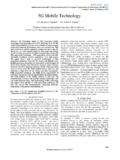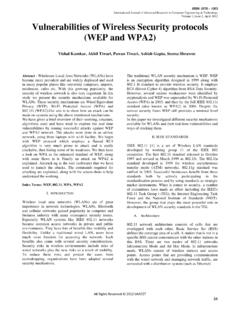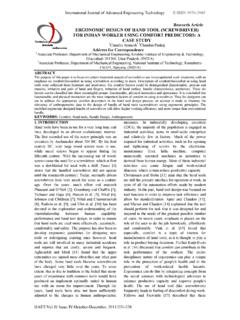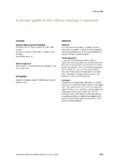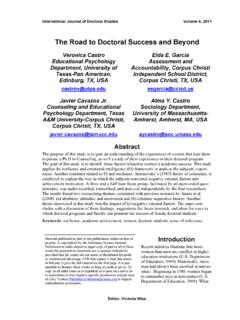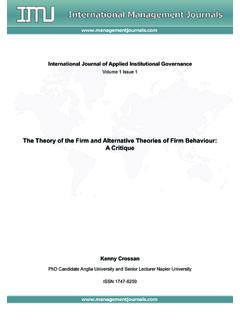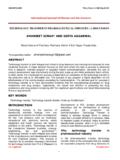Transcription of International Journal of Advanced Research in …
1 (5):(2015):35 4735 International Journal of Advanced Research in biological SciencesISSN : ArticleSerum level of IL-6, IL-10 and PCT as a prognostic marker in posttraumatic sepsis Lal Gupta1* Gupta3, Rao*1 Department of Biochemistry, All India Institute of Medical sciences , New Delhi, India2 Department of Emergency Medicine, JPNATC, All India Institute of Medical sciences , New Delhi, India3 Department of Surgery,JPNATC, All India Institute of Medical sciences , New Delhi, of Laboratory Medicine, JPNATC, All India Institute of Medical sciences , New Delhi, India*Corresponding authorAbstractBackground.
2 Trauma hemorrhagic shock (THS) leads to multiple organ failure (MOF) with sepsis and without sepsis. Theauthors studied the pattern and prognostic value of serum cytokines, chemokine, CRP, HMGB1 and PCT levels in patientsfallowing and methods:Serum levels of cytokines and other markers were determined on admission (Day 0)and 3, 7 and 14 days in patients and 50 healthy controls. Correlation between serum cytokine levels and SOFA score werecalculated in order to understand the importanceof these cytokines to multiple organ failure (MOF).
3 Results:Serum levels ofTNF- was found to be low and IL-10 levels were found to be high on day 0 in those THS patients who were died as a result ofsepsis in the ICU. Serum levels of CRP and procalcitonin were found to be elevated in those THS patients who developed procalcitonin level was found to be elevated in death patients due to sepsis and discriminate the sepsis patients with severesepsis. Our data show that serum cytokine disturbance patterns have prognostic significance in sepsis :Thesignificantly elevated serum level of IL-6, IL-10 and PCT, is associated with enhanced risk of fatal outcome for THS :Injury severity score, Sequential organ failure assessment assay, Shock Index, Trauma hemorrhagic shock (THS).
4 IntroductionTrauma hemorrhagic shock (THS)is a pathologic statein which intravascular volume and oxygen delivery areimpaired. As long as this bleeding is not controlled,the physician must maintain oxygen delivery to limittissue hypoxia, inflammation and organ procedure involves fluid resuscitation, use ofvasopressors and blood transfusion to prevent orcorrect traumatic complicatedwith multiple organ dysfunction syndromes (MODS)is a leading cause of death and disability in theintensivecare units with mortality rate exceeding 50%2. Those who survive the initial hours have additionallife-threatening risk of developing, SIRS, sepsis withand without MODS.
5 Post-traumatic sepsis, arises as aresult of inappropriate immune inflammatoryresponses, is considered as one of the commonlyobserved problems associated in THS patients. Theearly diagnosis of sepsis and evaluation of its severityis highly variable due to non-specific nature of thesigns and symptoms3. However, early diagnosis andstratification of the severity of sepsis is critical forstarting early goal directed therapy. Theimmunological response to THS involves not onlyinflammatory cytokines but alsoanti-inflammatorycytokines, humoral and cellular reactions andcirculatory abnormalities4, the use ofmodern antibiotics and resuscitation therapies, sepsisis one of the major causes of death in critically illpatients6.
6 The rise of antibiotic resistanceisalso (5):(2015):35 4736major challenge that calls for novel bio-markers toguide and limit drug usage. So, here it is important tounderstand the profiling of serum cytokines atdifferent time points in THS patients and correlateswith disease hypothesized that comprehensive profiling ofserum levels of multiple cytokines would providegreater insight into their utility for staging patientswith sepsis, compared with previous studies focusingon a single biomarker. In this study, we quantitativelyanalyzed 13 markers including serum cytokines,chemokines, procalcitonin (PCT), C-reactive proteins(CRP) and High mobility group box 1(HMGB-1)protein in serum samples from 96 hemorrhagic shockpatients on different days (0, 3, 7 and 14)
7 Afterhaemorrhage and outcomes of patients were observedin the form of death with and without , we observed when do the traumahemorrhagic shock patients develop the sign of sepsisand what are the changes in the serum levels ofcytokines in these patients in comparison with thosewho did not develop sepsis. The final outcome ofpatients in the form of death and survival wasobserved till 30 days of observational and Patient s characteristics:Patients of either sex with age 16-60 years withsystolic blood pressure (SBP 90 mmHg), presentingwithin the 8 hr of trauma were recruited after takingthe consent from the patients relatives.
8 Those patientswho had neurogenic shock, traumatic brain injury(TBI), septic shock and already resuscitated withfluids (colloids or crystalloids), anti-inflammatorydrugs or corticosteroids and blood or bloodcomponents before reporting to the EmergencyDepartment (ED) were excluded from this samplesof those THS patients who have SBP 90 mmHgwere collected at different time points ondays 0, 3, 7 and 14. Severity was assessed by Injuryseverity score (ISS) and Shock Index ( ) in theEmergency Department and the development of organdysfunction wasassessed by the Sequential OrganFailure Assessment score (SOFA; range, 0 24).
9 Mortality was defined as those patients who died up to30 days after the onset of hemorrhagic classified as a survivor if they were dischargedalive from the , we have categorised the patients in two broadcategories those who developed sepsis complicationand other those who did not during the 30 days ofobservational period. The inclusion, exclusion criteriaalong with distribution of patientswere shown inconsort diagram (Fig. 1S, Supplementary result). Sample Collection:-Collection of FirstBlood Sample: All patients were managed accordingto the protocol of American College of SurgeonsAdvanced Trauma Life Support (ATLS).
10 Patientswerestabilized (SBP=105 mmHg) with crystalloids butwithout blood or blood components for the firstsample, which was collected on the Day 0 in the Consecutive Blood Sampleswere collected ondays 3, 7 and 14 irrespective of blood blood sampling was terminated in patientwho refused for further sampling or if patientstransferred to another samples were also collected from 50 healthy,age matched, uninjured individuals who formed thecontrol group foranalysis of serum cytokines. Bloodsamples were collected; serum was separated andstored at-200C for cytokine Definitions, Scoring of Severity, andOutcome:Abbreviated injury scale (AIS) scores oftraumatic injuries induced while living and diagnosedby autopsy were determined using the 1985 protocolof the American Association for AutomotiveMedicine.

